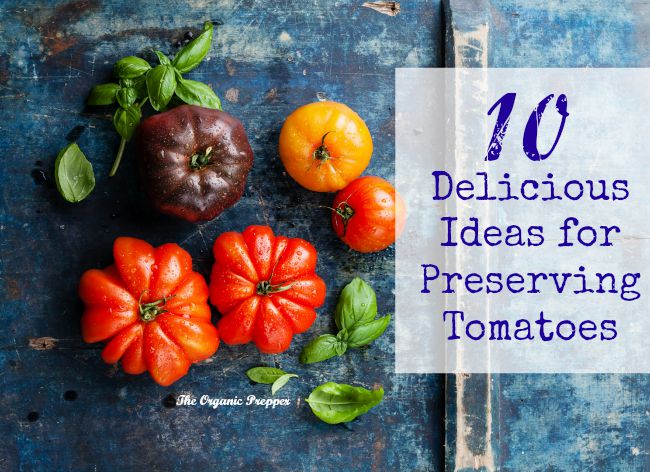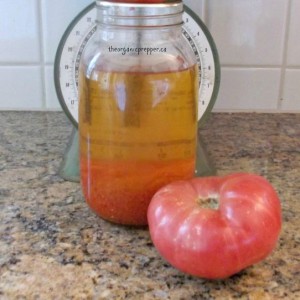If you're new here, you may want to subscribe to my RSS feed. Thanks for visiting!
By Daisy Luther
The best part of late summer is the glorious tomatoes. Once you’ve eaten all of the BLTs that you can hold, it’s time to start preserving tomatoes for later. Here are 10 delicious ways to prolong that taste of summer throughout the year.
Dried Tomatoes Packed in Oil
To dry tomatoes, slice them to about 1/4 inch thick and lay them on dehydrator sheets. (If you have a different type of dehydrator, you can buy netting by the roll and cut sheets to fit your unit.) If you want, you can sprinkle them with Italian herbs. like basil and oregano. Dry them for about 8 hours at 140 degrees. Place them in a dry, sanitized jar and cover them with olive oil. Food safety experts recommend that this be stored in the refrigerator.
Dried Tomato Powder
Follow the directions above, but dehydrate the slices until they are crisp and brittle. Allow the dried tomatoes to cool, then, using a food processor (I use my Ninja kitchen system) turn them into a powder. This stores a lot of tomato nutrition in a very small space. Tomato powder can be added to soups and sauces for a bump in flavor and vitamins.
Freezing Tomatoes
Tomatoes can be frozen whole, in the skin. Wash the tomatoes in a sink full of baking soda and water, then rinse them will. Place them in a gallon sized freezer bag, and then place the bags on a cookie sheet in the freezer to allow them to freeze nice and flat for ease of storage. When it’s time to use them, place the bag in a bowl on the counter to thaw. The skins will come right off with a gentle pull and your tomatoes are ready to use.
Prepping Tomatoes for Canning or Cooking
This article gives you the how-to for prepping tomatoes for canning. Below, find a few quick recipes for canning your tomatoes and some links to other, more involved recipes.
Canning a Simple Tomato Sauce
This thin puree is as simple as running your tomatoes through the blender, and possibly adding some garlic, onions, and salt to them. It can be used as a base for soup, chili, spaghetti sauce, enchilada sauce, or any other purpose that requires crushed tomatoes. I like to can this because it’s pretty neutral and can be used in so many different recipes throughout the year.
I didn’t give measurements because this simple sauce can be made from any amount of tomatoes that you happen to lay hands upon. It is also a great way to use up soft or overripe tomatoes quickly.
Ingredients:
- Peeled tomatoes (any variety)
- 1/2 a small onion per jar
- 1 clove of garlic per jar
- Sea salt or canning salt to taste
- 1 tsp. of lemon juice per quart jar
Directions:
- Peel tomatoes and place them directly into the bowl of your food processor or pitcher of your blender. Approximately 3 cups of unprocessed tomato will fill a quart jar. If you’re using onions and garlic, add those to the food processor at the same time.
- Use the pulse option on your processor until the mixture reaches your desired consistency.
- Pour this into a sanitized quart jar.
- Repeat until you have a canner load of sauce.
- Add a dash of salt to each jar. If you are water bath canning, add 2 tbsp of lemon juice to each jar. If you are pressure canning, the lemon juice is not necessary.
- In a water bath canner, process your sauce for 40 minutes at sea level, adjusting for altitude. Alternatively, you can process the sauce in your pressure canner for 25 minutes at 10 pounds of pressure, adjusting for altitude.
Straining Tomatoes for Less Waste
Instead of cooking tomatoes down for hours and letting all of that goodness just evaporate, I decided to use the same method that I use for pectin-free jam-making with some of my tomato products.
When processing tomatoes for marinara, salsa, and ketchup, cut down the cooking time and preserve the extra liquid for a vegetable broth base for soup or cooking rice.
Puree your tomatoes, then pour the puree into a lined colander that is resting over a large stockpot. (I use a flour sack towel for lining the colander.)
Let it drain anywhere from 2 hours to overnight. The longer it drains, of course, the less liquid will remain in the sauce. The liquid that drains off can then be processed as a tomato broth for soup.
You’ll be left with thick tomato-ey goodness that doesn’t require a half-day of cooking to reach the proper consistency.
Canning Tomato Broth
- Strain your liquid as described above.
- Pour this into a sanitized quart jar.
- Add a dash of salt to each jar. If you are water bath canning, add 2 tbsp of lemon juice to each jar. If you are pressure canning, the lemon juice is not necessary.
- In a water bath canner, process your broth for 40 minutes at sea level, adjusting for altitude. Alternatively, you can process the broth in your pressure canner for 20 minutes at 10 pounds of pressure, adjusting for altitude.
The liquid will separate and you will have tomato “sediment” at the bottom. (See the photo) This is perfectly normal. Just shake the jar before using it to mix the liquid and the pulp. This broth can be used as a base for soup, in place of liquid for cooking meat in the crock pot, or for cooking rice.
More Tomato Canning Recipes
For even more recipes, check out my canning website and my canning cookbook.
Recommended products
I use the following products when preserving tomatoes. (You probably already have many of these in your kitchen!)
Excelsteel 16 Quart Stainless Steel Stockpot
Presto 23-Quart Pressure Canner
Granite Ware Water Bath Canner
Flour Sack Towels
How do you preserve tomatoes?
What is your favorite way to preserve tomatoes? Share in the comments below!


















4 Responses
Extremely helpful. We have so many tomatoes this year, they’re like the zombies in the walking dead – think you got them all, turn around and there’s another dozen of them.
Definitely freezing is my favourite way to go. So easy and versatile. I have slow-roasted tomatoes too but they are so tasty that they don’t last longer than a few days so I’ve never gotten around to preserving them!
I like to slice them about 1/8th inch thick, briefly coat them in vinegar, place the slices on metal cooling racks and put them in the sun for a few hours. The sun dries the slices into a kind of delicious fruit leather that you can add to all sorts of savory dishes. I’ve not had problems with flies but if you’re worried get some of those picnic protector cage things.
We use our Victoria Strainer and process our Romas. We turn the tomato goodness into 120 or so quarts adding celery, peppers, carrots, sugar, salt, oil and seasonings. This gives us the ability to make soups, spaghetti sauce, chili, awesome bloody mary’s etc. We cook it long enough to bring it to a boil for canning. We use it all year long and give a lot away. Liquid gold!